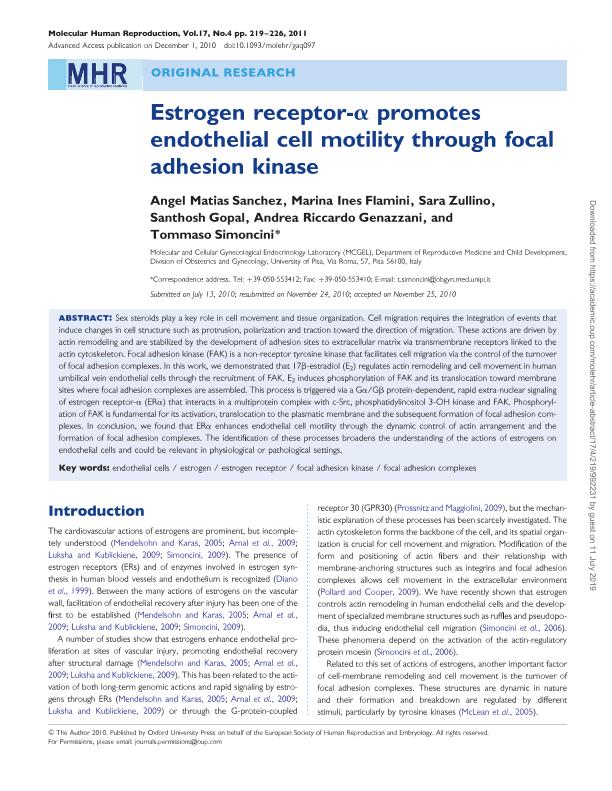Mostrar el registro sencillo del ítem
dc.contributor.author
Sanchez, Angel Matias

dc.contributor.author
Flamini, Marina Ines

dc.contributor.author
Zullino, Sara
dc.contributor.author
Gopal, Santhosh
dc.contributor.author
Genazzani, Andrea Riccardo
dc.contributor.author
Simoncini, Tommaso
dc.date.available
2019-07-25T21:58:16Z
dc.date.issued
2011-04
dc.identifier.citation
Sanchez, Angel Matias; Flamini, Marina Ines; Zullino, Sara; Gopal, Santhosh; Genazzani, Andrea Riccardo; et al.; Estrogen receptor-α promotes endothelial cell motility through focal adhesion kinase; Oxford University Press; Molecular Human Reproduction; 17; 4; 4-2011; 219-226
dc.identifier.issn
1360-9947
dc.identifier.uri
http://hdl.handle.net/11336/80343
dc.description.abstract
Sex steroids play a key role in cell movement and tissue organization. Cell migration requires the integration of events that induce changes in cell structure such as protrusion, polarization and traction toward the direction of migration. These actions are driven by actin remodeling and are stabilized by the development of adhesion sites to extracellular matrix via transmembrane receptors linked to the actin cytoskeleton. Focal adhesion kinase (FAK) is a non-receptor tyrosine kinase that facilitates cell migration via the control of the turnover of focal adhesion complexes. In this work, we demonstrated that 17β-estradiol (E2) regulates actin remodeling and cell movement in human umbilical vein endothelial cells through the recruitment of FAK. E2 induces phosphorylation of FAK and its translocation toward membrane sites where focal adhesion complexes are assembled. This process is triggered via a Gα/Gβ protein-dependent, rapid extra-nuclear signaling of estrogen receptor-a (ERa) that interacts in a multiprotein complex with c-Src, phosphatidylinositol 3-OH kinase and FAK. Phosphorylation of FAK is fundamental for its activation, translocation to the plasmatic membrane and the subsequent formation of focal adhesion complexes. In conclusion, we found that ERα enhances endothelial cell motility through the dynamic control of actin arrangement and the formation of focal adhesion complexes. The identification of these processes broadens the understanding of the actions of estrogens on endothelial cells and could be relevant in physiological or pathological settings.
dc.format
application/pdf
dc.language.iso
eng
dc.publisher
Oxford University Press

dc.rights
info:eu-repo/semantics/openAccess
dc.rights.uri
https://creativecommons.org/licenses/by-nc-sa/2.5/ar/
dc.subject
Endothelial Cells
dc.subject
Estrogen
dc.subject
Estrogen Receptor
dc.subject
Focal Adhesion Complexes
dc.subject
Focal Adhesion Kinase
dc.subject.classification
Bioquímica y Biología Molecular

dc.subject.classification
Medicina Básica

dc.subject.classification
CIENCIAS MÉDICAS Y DE LA SALUD

dc.title
Estrogen receptor-α promotes endothelial cell motility through focal adhesion kinase
dc.type
info:eu-repo/semantics/article
dc.type
info:ar-repo/semantics/artículo
dc.type
info:eu-repo/semantics/publishedVersion
dc.date.updated
2019-06-10T21:21:26Z
dc.journal.volume
17
dc.journal.number
4
dc.journal.pagination
219-226
dc.journal.pais
Reino Unido

dc.journal.ciudad
Oxford
dc.description.fil
Fil: Sanchez, Angel Matias. Università degli Studi di Pisa; Italia. Consejo Nacional de Investigaciones Científicas y Técnicas. Centro Científico Tecnológico Conicet - Mendoza. Instituto de Medicina y Biología Experimental de Cuyo; Argentina
dc.description.fil
Fil: Flamini, Marina Ines. Università degli Studi di Pisa; Italia
dc.description.fil
Fil: Zullino, Sara. Università degli Studi di Pisa; Italia
dc.description.fil
Fil: Gopal, Santhosh. Università degli Studi di Pisa; Italia
dc.description.fil
Fil: Genazzani, Andrea Riccardo. Università degli Studi di Pisa; Italia
dc.description.fil
Fil: Simoncini, Tommaso. Università degli Studi di Pisa; Italia
dc.journal.title
Molecular Human Reproduction

dc.relation.alternativeid
info:eu-repo/semantics/altIdentifier/doi/http://dx.doi.org/10.1093/molehr/gaq097
dc.relation.alternativeid
info:eu-repo/semantics/altIdentifier/url/https://academic.oup.com/molehr/article/17/4/219/992231
Archivos asociados
